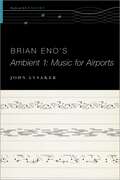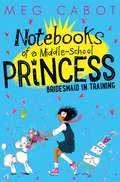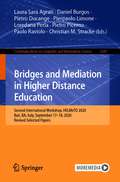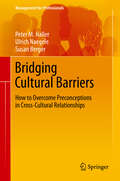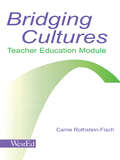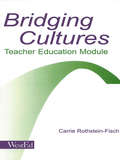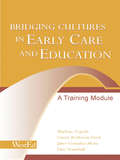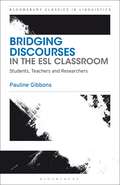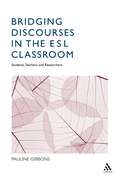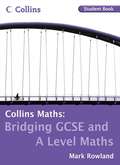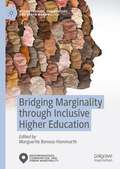- Table View
- List View
BRIAN ENO'S AMBIENT 1 OKS C (The Oxford Keynotes Series)
by John T. LysakerBrian Eno's seminal album Ambient 1: Music for Airports continues to fascinate and charm audiences, not only as a masterpiece of ambient music, but as a powerful and transformative work of art. Author John T. Lysaker situates this album in the context of twentieth-century art music, where its ambitions and contributions to avant garde music practice become even more apparent. To appreciate the album's multifaceted character, Lysaker advocates for "prismatic listening," an attentiveness that continually shifts registers in the knowledge that no single approach can grasp the work as a whole. Exploring each of the album's four tracks and their unique sonic arrangements, Brian Eno's Ambient 1: Music for Airports argues that the album must be approached from at least three angles: as an ambient contribution to lived environments that draws upon cybernetics and the experiments of Erik Satie, as an exploration of what John Cage has termed the "activity of sounds," and as a work of conceptual art that asks us to think freshly about artistic creativity, listening, and the broad ecology of interactions that not only make art possible, but the full range of human meaning. If one listens in this way, Music for Airports becomes a sonic image that blurs the nature-culture distinction and rescues the most interesting concerns of avant-garde music from the social isolation of concert halls and performance spaces.
Bridesmaid-in-Training (Notebooks of a Middle-School Princess #2)
by Meg CabotBridesmaid in Training is the second in the Notebooks of a Middle-School Princess, a funny, heart-warming illustrated Princess Diaries series by Meg Cabot.Olivia Grace Clarisse Mignonette Harrison still finds it hard to believe that she's a princess! Not only does she get to live in an actual palace with her newly discovered family and two fabulous poodles, but she also gets her very own pony! Of course, not everything is going exactly as she imagined . . . her half-sister, Mia, is very busy learning how to run the country while trying to plan a wedding, and her father is getting remarried himself – to Mia's mother! – and spends most of his time 'renovating' the summer palace, although Grandmère says he is just hiding from the wedding madness. Olivia hardly gets to see either of them. Fortunately Grandmère has her own plans for Mia's wedding, and needs Olivia's help to pull them off. Just when Olivia starts to think that things are going to work out after all, the palace is invaded by a host of new cousins and other royals who all seem to be angry at Olivia (although Grandmère says they are just jealous). As the day of the wedding gets closer and closer, Olivia becomes more and more worried. For such a carefully planned event, it seems as if a LOT of things are going wrong . . . Can Olivia keep this royal wedding from becoming a royal disaster?Olivia chronicles her transformation from ordinary girl to princess in her notebook, with illustrations from author Meg Cabot, who studied Fine Arts as an undergraduate.
The Bridge Between Bioethics and Medical Practice: Medical Professionalism (The International Library of Bioethics #98)
by Marko Ćurković Ana BorovečkiThis book provides insights into dynamic and complex interrelationships between professionalism and medical practice. It does so by looking into the most relevant and recent theoretical and practical frameworks and by systematizing and integrating extensive and growing literature on medical professionalism. Through honest and prudent contributions from very diverse backgrounds and contexts, this book provides an understanding of medical professionalism derived from a broader historical and cultural context in order to contribute to everyday professional life and practice – the very place of its existence. The book presents the conflicting and sometimes irreconcilable demands and challenges physicians face in everyday practice. A better understanding of these fundamental issues is the only way for medicine to maintain and preserve its unique morality, the same one that enabled its existence in the first place. The book is relevant for everyone immersed and interested in the subject of medical professionalism as a resource, which may ease or guide them through the complexities of issues at hand. It will also contribute to the ongoing debate on medical professionalism, medical ethics, bioethics, and professionalism and ethics in general.
A Bridge To GCSE English Student Book
by Sarah Darragh Phil Darragh John ParryGive your students a flying start to GCSE English! Make a smooth transition from Key Stage 3 to GCSE. Designed to help students develop the skills and knowledge they will need for exam and controlled assessment success, A Bridge to GCSE helps you align your KS3 curriculum to the new GCSEs in English, English Language and English Literature. With a particular focus on tackling new topics such as unseen poetry or spoken language, and on building controlled assessment skills, A Bridge to GCSE English gives you the tools to make the end of Key Stage 3 fun, challenging and a firm foundation for GCSE.
The Bridge to School: Aligning Teaching with Development for Ages Four to Six
by Claire Bainer Liisa Hale Gail MyersThe Bridge to School provides concise, targeted information for teachers who work in PreK, Transitional Kindergarten, or Kindergarten settings, covering both the why and the how of play in classrooms, along with insights into how the normal development of 4-to-6-year-olds is manifested and how teachers can harness and work with those typical needs and behaviors. This powerful professional resource includes theories of child development, brain development, and the value of play-based learning, but the majority of the content is practical classroom strategies that fall in line with ECERS and allow for appropriate academic skill building.
The Bridge to School: Aligning Teaching with Development for Ages Four to Six
by Claire Bainer Liisa Hale Gail MyersThe Bridge to School provides concise, targeted information for teachers who work in PreK, Transitional Kindergarten, or Kindergarten settings, covering both the why and the how of play in classrooms, along with insights into how the normal development of 4-to-6-year-olds is manifested and how teachers can harness and work with those typical needs and behaviors. This powerful professional resource includes theories of child development, brain development, and the value of play-based learning, but the majority of the content is practical classroom strategies that fall in line with ECERS and allow for appropriate academic skill building.
Bridges and Mediation in Higher Distance Education: Second International Workshop, HELMeTO 2020, Bari, BA, Italy, September 17–18, 2020, Revised Selected Papers (Communications in Computer and Information Science #1344)
by Laura Sara Agrati Daniel Burgos Pietro Ducange Pierpaolo Limone Loredana Perla Pietro Picerno Paolo Raviolo Christian M. StrackeThis book constitutes the thoroughly refereed post-conference proceedings of the Second International Workshop on Higher Education Learning Methodologies and Technologies Online, HELMeTO 2020, held in Bari, Italy, September 2020. Due to the COVID-19 pandemic the conference was held online. The 25 revised full papers and 3 short papers presented were carefully reviewed and selected from a total of 59 submissions. The papers present recent research on challenges of implementing emerging technology solution for online, online learning pedagogical frameworks, facing COVID19 emergency in higher education teaching and learning, online learning technologies in practice, online learning strategies and resources, etc.
Bridging between Research and Practice: Supporting Professional Development through Collaborative Studies of Classroom Teaching with Technology (Professional Learning #0)
by Sara HennessyThis book presents a fresh approach to bridging the perceived gap between academic and classroom cultures. It describes a unique form of research partnership whereby Cambridge University academics and school teachers together grappled with and reformulated theory – through in-depth case studies analysing practice using interactive whiteboards in five subject areas. The inquiry exploited the collaborators’ complementary professional knowledge bases. Teachers’ voices are particularly audible in co-authored case study chapters. Outcomes included deeper insights into concepts of sociocultural learning theory and classroom dialogue, more analytical mindsets, sustained new practices and ways of working collegially. The book reflects upon the power of lesson video review and details how the co-inquirers negotiated “intermediate theory” – bridging educational theory and specific settings – framed in mutually accessible language and embodied in interactive multimedia resources for teacher development. These include video clips, analytic commentary from multiple perspectives, lesson materials, plus optional prompts for reflection and critique – not models of “best practice”. The resources make pedagogy explicit and vividly illustrate the book’s ideas, offering theory-informed yet practical tools designed with and for practitioners. Hennessy and colleagues have tested a model of ongoing, teacher-led development and innovation, professional dialogue and classroom trialing stimulated by discussing selected multimedia resources. The book will interest academic and teacher researchers, initial teacher educators, professional development leaders, mentors, plus practitioners interested in using interactive whiteboards and dialogic teaching. It explores widening approaches to collegial development to reach educators working in other contexts (with and without technology). This could involve intermediate theory building or shortcutting by sharing and adapting the outcomes – springboarding teachers’ further critique and professional learning. “I cannot recommend this book too highly … it weaves a complex developmental story with a range of facets. It emphasises clearly the rigour of the research that was conducted, while demonstrating the complexity of the inter-relationships, practices and issues for both teachers and researchers in developing practical and theoretical knowledge. Its graphic insights through text and associated media provide exemplars for teachers and those who work with teachers as a rich resource. It shows us all what can be achieved and the means of achieving it.” Prof. Barbara Jaworski, University of Loughborough
Bridging Communities through Socially Engaged Art (Routledge Advances in Art and Visual Studies)
by Alice Wexler Vida SabbaghiPromoting the expansion of art in society and education, this book highlights the significance of the arts as an instrument of social justice, inclusion, equity, and protection of the environment. Including twenty-seven diverse case studies of socially engaged art practice with groups like the Black Lives Matter movement, the LGBTQ community, and Rikers Island, this book guides art educators toward innovative, transdisciplinary, and diverse methodologies. A valuable resource on creating spaces for change, it addresses the relationships between artists and educators, museums and communities.
Bridging Communities through Socially Engaged Art (Routledge Advances in Art and Visual Studies)
by Alice Wexler Vida SabbaghiPromoting the expansion of art in society and education, this book highlights the significance of the arts as an instrument of social justice, inclusion, equity, and protection of the environment. Including twenty-seven diverse case studies of socially engaged art practice with groups like the Black Lives Matter movement, the LGBTQ community, and Rikers Island, this book guides art educators toward innovative, transdisciplinary, and diverse methodologies. A valuable resource on creating spaces for change, it addresses the relationships between artists and educators, museums and communities.
Bridging Cultural Barriers: How to Overcome Preconceptions in Cross-Cultural Relationships (Management for Professionals)
by Peter M. Haller Ulrich Naegele Susan BergerThis book provides readers with a comprehensive guide to other cultures – the often-unfamiliar ways that people from other cultures think, speak and act. As such, it helps readers identify potential and real conflicts, and to take appropriate action so as to build successful relationships. The book draws on the authors’ combined experience from international line management and international projects, as well as teaching seminars and coaching clientele from around the globe. It offers an essential resource for anyone involved in transnational business and cross-border relationships.
Bridging Cultures: Teacher Education Module
by Carrie Rothstein-FischBridging Cultures: Teacher Education Module is a professional development resource for teacher educators and staff developers to help preservice and in-service teachers become knowledgeable about cultural differences and understand ways of bridging the expectations of school settings with those of the home. In a nonthreatening, cognitively meaningful way, the Module is based on teacher-constructed and tested strategies to improve home-school communication and parent involvement. These innovations were developed as part of the Bridging Cultures Project, which explores the cultural value differences between the individualistic orientation of mainstream U.S. schools and the collectivistic orientation of many immigrant families. The goal of the Bridging Cultures Project is to support and help teachers in their work with students and families from immigrant cultures. The centerpiece of the Module is training resources, including an outline, an agenda, and a well-tested three-hour script designed as a lecture-discussion with structured opportunities for guided dialogue and small-group discussion. Throughout the script, "Facilitators Notes" annotate presentation suggestions and oversized margins encourage integration of the facilitator's personal experiences in presenting and adapting the Module. Ideas for using the Readings for Bridging Cultures are provided. A section of overhead transparencies and handout masters is included. The Module also provides a discussion of the role of culture in education and the constructs of individualism and collectivism, an overview of the effects of the Bridging Cultures Project, and evaluation results of the author's use of the Module in two sections of a preservice teacher education course. Bridging Cultures: Teacher Education Module brings the successful processes and practices of the Bridging Cultures Project to a larger audience in college courses and in professional development arenas. Designed for use in one or two class sessions, the Module can be incorporated in courses on educational psychology, child development, counseling psychology, and any others that deal with culture in education.
Bridging Cultures: Teacher Education Module
by Carrie Rothstein-FischBridging Cultures: Teacher Education Module is a professional development resource for teacher educators and staff developers to help preservice and in-service teachers become knowledgeable about cultural differences and understand ways of bridging the expectations of school settings with those of the home. In a nonthreatening, cognitively meaningful way, the Module is based on teacher-constructed and tested strategies to improve home-school communication and parent involvement. These innovations were developed as part of the Bridging Cultures Project, which explores the cultural value differences between the individualistic orientation of mainstream U.S. schools and the collectivistic orientation of many immigrant families. The goal of the Bridging Cultures Project is to support and help teachers in their work with students and families from immigrant cultures. The centerpiece of the Module is training resources, including an outline, an agenda, and a well-tested three-hour script designed as a lecture-discussion with structured opportunities for guided dialogue and small-group discussion. Throughout the script, "Facilitators Notes" annotate presentation suggestions and oversized margins encourage integration of the facilitator's personal experiences in presenting and adapting the Module. Ideas for using the Readings for Bridging Cultures are provided. A section of overhead transparencies and handout masters is included. The Module also provides a discussion of the role of culture in education and the constructs of individualism and collectivism, an overview of the effects of the Bridging Cultures Project, and evaluation results of the author's use of the Module in two sections of a preservice teacher education course. Bridging Cultures: Teacher Education Module brings the successful processes and practices of the Bridging Cultures Project to a larger audience in college courses and in professional development arenas. Designed for use in one or two class sessions, the Module can be incorporated in courses on educational psychology, child development, counseling psychology, and any others that deal with culture in education.
Bridging Cultures Between Home and School: A Guide for Teachers
by Elise Trumbull Carrie Rothstein-Fisch Patricia M. Greenfield Blanca QuirozBridging Cultures Between Home and School: A Guide for Teachers is intended to stimulate broad thinking about how to meet the challenges of education in a pluralistic society. It is a powerful resource for in-service and preservice multicultural education and professional development. The Guide presents a framework for understanding differences and conflicts that arise in situations where school culture is more individualistic than the value system of the home. It shares what researchers and teachers of the Bridging Cultures Project have learned from the experimentation of teacher-researchers in their own classrooms of largely immigrant Latino students and explores other research on promoting improved home-school relationships across cultures. The framework leads to specific suggestions for supporting teachers to cross-cultural communication; organization parent-teacher conferences that work; use strategies that increase parent involvement in schooling; increase their skills as researchers; and employ ethnographic techniques to learn about home cultures. Although the research underlying the Bridging Cultures Project and this Guide focuses on immigrant Latino families, since this is the primary population with which the framework was originally used, it is a potent tool for learning about other cultures as well because many face similar discrepancies between their own more collectivistic approaches to childrearing and schooling and the more individualistic approach of the dominant culture.
Bridging Cultures Between Home and School: A Guide for Teachers
by Elise Trumbull Carrie Rothstein-Fisch Patricia M. Greenfield Blanca QuirozBridging Cultures Between Home and School: A Guide for Teachers is intended to stimulate broad thinking about how to meet the challenges of education in a pluralistic society. It is a powerful resource for in-service and preservice multicultural education and professional development. The Guide presents a framework for understanding differences and conflicts that arise in situations where school culture is more individualistic than the value system of the home. It shares what researchers and teachers of the Bridging Cultures Project have learned from the experimentation of teacher-researchers in their own classrooms of largely immigrant Latino students and explores other research on promoting improved home-school relationships across cultures. The framework leads to specific suggestions for supporting teachers to cross-cultural communication; organization parent-teacher conferences that work; use strategies that increase parent involvement in schooling; increase their skills as researchers; and employ ethnographic techniques to learn about home cultures. Although the research underlying the Bridging Cultures Project and this Guide focuses on immigrant Latino families, since this is the primary population with which the framework was originally used, it is a potent tool for learning about other cultures as well because many face similar discrepancies between their own more collectivistic approaches to childrearing and schooling and the more individualistic approach of the dominant culture.
Bridging Cultures in Early Care and Education: A Training Module
by Marlene Zepeda Janet Gonzalez-Mena Carrie Rothstein-Fisch Elise TrumbullBridging Cultures in Early Care and Education: A Training Module is a resource designed to help pre-service and in-service early childhood educators, including infant-toddler caregivers, understand the role of culture in their programs. It is also intended for professionals who work with children and their families in a variety of other roles, such as social workers, special educators, and early interventionists, and for use in college courses focused on early childhood education and child development.The module explains and illustrates how early childhood educators can use the organizing concepts of individualism and collectivism as a means of understanding cultural conflict and difference. These concepts have been shown to be highly useful in improving home-school understanding across cultures. Based on real-life examples of cultural dilemmas in early care and education settings, participants engage the concepts of individualism and collectivism to solve a variety of scenarios in a dynamic and engaging manner.*Chapter 1 introduces the Bridging Cultures for Early Care and Education approach, provides a brief history, and explains the training module. It presents the conceptual framework of individualism and collectivism, which is at the heart of the training.*Chapter 2 provides the information needed for a two-hour workshop, including a script and notes to the facilitator. The script is not meant to be read word for word. Rather, it is offered as a guide, based on a pilot-tested approach. Appendices at the end of the book contain transparency masters for the overheads referenced in the script, and masters for suggested handouts.*Chapter 3 offers ideas for augmenting the basic two-hour training by expanding it over a longer time period. It also identifies additional diversity resources that can complement the Bridging Cultures training.*Appendices providing additional information, data, and bibliographic resources are included. This module originated as part of the Bridging Cultures Project at WestEd--a nonprofit research, development, and service agency working with education and other communities to promote excellence, achieve equity, and improve learning for children, youth, and adults.
Bridging Cultures in Early Care and Education: A Training Module
by Marlene Zepeda Janet Gonzalez-Mena Carrie Rothstein-Fisch Elise TrumbullBridging Cultures in Early Care and Education: A Training Module is a resource designed to help pre-service and in-service early childhood educators, including infant-toddler caregivers, understand the role of culture in their programs. It is also intended for professionals who work with children and their families in a variety of other roles, such as social workers, special educators, and early interventionists, and for use in college courses focused on early childhood education and child development.The module explains and illustrates how early childhood educators can use the organizing concepts of individualism and collectivism as a means of understanding cultural conflict and difference. These concepts have been shown to be highly useful in improving home-school understanding across cultures. Based on real-life examples of cultural dilemmas in early care and education settings, participants engage the concepts of individualism and collectivism to solve a variety of scenarios in a dynamic and engaging manner.*Chapter 1 introduces the Bridging Cultures for Early Care and Education approach, provides a brief history, and explains the training module. It presents the conceptual framework of individualism and collectivism, which is at the heart of the training.*Chapter 2 provides the information needed for a two-hour workshop, including a script and notes to the facilitator. The script is not meant to be read word for word. Rather, it is offered as a guide, based on a pilot-tested approach. Appendices at the end of the book contain transparency masters for the overheads referenced in the script, and masters for suggested handouts.*Chapter 3 offers ideas for augmenting the basic two-hour training by expanding it over a longer time period. It also identifies additional diversity resources that can complement the Bridging Cultures training.*Appendices providing additional information, data, and bibliographic resources are included. This module originated as part of the Bridging Cultures Project at WestEd--a nonprofit research, development, and service agency working with education and other communities to promote excellence, achieve equity, and improve learning for children, youth, and adults.
Bridging Discourses in the ESL Classroom: Students, Teachers and Researchers (Bloomsbury Classics in Linguistics)
by Pauline GibbonsBridging Discourses in the ESL Classroom is concerned with the nature of talk in multilingual classrooms. Examining the interactions between students learning in and through English as a second language and their teachers, this book identifies the patterns of discourse which support and enable both second language development and the learning of curriculum knowledge. These patterns are 'bridging discourses', combining the everyday language used by the student with the specialised language of the academic register.Drawing on second language acquisition research and systemic functional linguistic theory, in particular the work of Halliday and Vygotsky, Pauline Gibbons develops tools to view classroom talk through a powerful interdisciplinary lens. Putting forward an innovative new theory of classroom discourse analysis, this book focuses on applying theory to practice. This is an invaluable resource for all teachers, researchers and students of linguistics and education.
Bridging Discourses in the ESL Classroom: Students, Teachers and Researchers
by Pauline GibbonsBridging Discourses in the ESL Classroom examines the interactions between learners and teachers in the language classroom. It aims to identify patterns of discourse which enable second language development but also support the learning of curriculum knowledge. These patterns are 'bridging discourses' in that they combine the everyday language used by the student, with the specialised language of the academic register. This book puts forward an innovative new theory of classroom discourse analysis, influenced by the work of Halliday and Vygotsky. It is recommended for academics and postgraduates researching applied linguistics and education.
Bridging Discourses in the ESL Classroom: Students, Teachers and Researchers (Bloomsbury Classics in Linguistics)
by Pauline GibbonsBridging Discourses in the ESL Classroom is concerned with the nature of talk in multilingual classrooms. Examining the interactions between students learning in and through English as a second language and their teachers, this book identifies the patterns of discourse which support and enable both second language development and the learning of curriculum knowledge. These patterns are 'bridging discourses', combining the everyday language used by the student with the specialised language of the academic register.Drawing on second language acquisition research and systemic functional linguistic theory, in particular the work of Halliday and Vygotsky, Pauline Gibbons develops tools to view classroom talk through a powerful interdisciplinary lens. Putting forward an innovative new theory of classroom discourse analysis, this book focuses on applying theory to practice. This is an invaluable resource for all teachers, researchers and students of linguistics and education.
Bridging Educational Leadership, Curriculum Theory and Didaktik: Non-affirmative Theory of Education (Educational Governance Research #5)
by Michael Uljens Rose M. YlimakiThis book is open access under a CC BY 4.0 license. This volume argues for the need of a common ground that bridges leadership studies, curriculum theory, and Didaktik. It proposes a non-affirmative education theory and its core concepts along with discursive institutionalism as an analytical tool to bridge these fields. It concludes with implications of its coherent theoretical framing for future empirical research.Recent neoliberal policies and transnational governance practices point toward new tensions in nation state education. These challenges affect governance, leadership and curriculum, involving changes in aims and values that demand coherence. Yet, the traditionally disparate fields of educational leadership, curriculum theory and Didaktik have developed separately, both in terms of approaches to theory and theorizing in USA, Europe and Asia, and in the ways in which these theoretical traditions have informed empirical studies over time. An additional aspect is that modern education theory was developed in relation to nation state education, which, in the meantime, has become more complicated due to issues of ‘globopolitanism’. This volume examines the current state of affairs and addresses the issues involved. In doing so, it opens up a space for a renewed and thoughtful dialogue to rethink and re-theorize these traditions with non-affirmative education theory moving beyond social reproduction and social transformation perspectives.
Bridging GCSE and A Level Maths: Student Book (PDF)
by Mark RowlandEnsure students are fully prepared for A Level Maths with practice in essential and tricky topics such as algebra. Revisit areas that may not have been studied recently due to modular courses to fill gaps in knowledge and make links. Prepare students for some of the skills required at A Level with a focus on applications of mathematics.
Bridging Human Intelligence and Artificial Intelligence (Educational Communications and Technology: Issues and Innovations)
by Lin Lin Michael J. Spector Mark V. Albert Lemoyne S. DunnThis edited volume is based on contributions from the TCET-AECT “Human-Technology Frontier: Understanding the Learning of Now to Prepare for the Work of the Future Symposium” held in Denton, Texas on May 16-18, sponsored by AECT. The authors embrace an integrative approach to designing and implementing advances technologies in learning and instruction, and focus on the emerging themes of artificial intelligence, human-computer interactions, and the resulting instructional design. The volume will be divided into four parts: (1) Trends and future in learning and learning technologies expected in the next 10 years; (2) Technologies likely to have a significant impact on learning in the next 10 years; (3) Challenges that will need to be addressed and resolved in order to achieve significant and sustained improvement in learning; and (4) Reflections and insights from the Symposium that should be pursued and that can form the basis for productive research collaborations. The primary audience for this volume is academics and researchers in disciplines such as artificial intelligence, cognitive science, computer science, educational psychology, instructional design, human-computer interactions, information science, library science, and technology integration.
Bridging Literacies with Videogames (Gaming Ecologies and Pedagogies Series #0)
by Hannah R. Gerber Sandra Schamroth AbramsBridging Literacies with Videogames provides an international perspective of literacy practices, gaming culture, and traditional schooling. Featuring studies from Australia, Colombia, South Korea, Canada, and the United States, this edited volume addresses learning in primary, secondary, and tertiary environments with topics related to: • re-creating worlds and texts • massive multiplayer second language learning • videogames and classroom learning These diverse topics will provide scholars, teachers, and curriculum developers with empirical support for bringing videogames into classroom spaces to foster meaning making. Bridging Literacies with Videogames is an essential text for undergraduates, graduates, and faculty interested in contemporizing learning with the medium of the videogame.
Bridging Marginality through Inclusive Higher Education (Neighborhoods, Communities, and Urban Marginality)
by Marguerite Bonous-HammarthThis book examines the changing influences of diversity in American higher education. The volume offers evidence and recommendations to positively shape inclusive learning and engagement of students, faculty, staff and community across the complex terrains of urban, suburban, and rural organizations within higher education today. Chapters highlight critical collaborations across student affairs and academic affairs, and delve into milestones addressing access, retention, engagement, and thriving within distinctive institutional types (e.g., research, liberal arts, community colleges, Minority Serving Institutions). Authors also explore the nuanced changes occurring against the contemporary backdrop of COVID-19 experiences – including the rise of anti-Asian racism, the salience of implicit biases, and the disparate access to and impacts of health services. Essential chapters refocus our consideration about the trajectories of historically underrepresented groups and their peers (including, African Americans, Hispanic/Latino, Indigenous people, individuals with disabilities and those identifying as LGBTQ+, undocumented students, and women) in American higher education.
